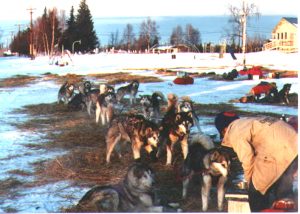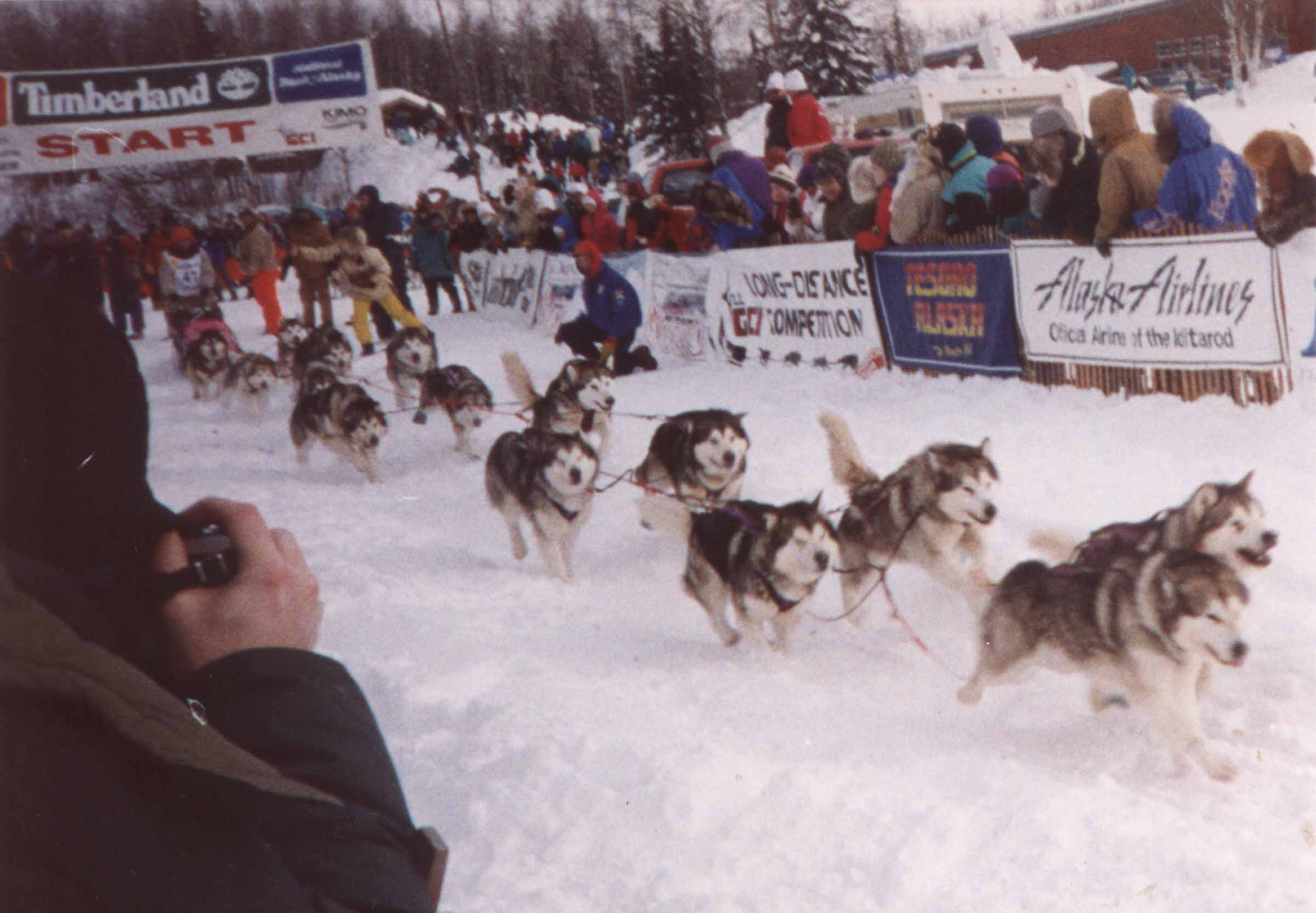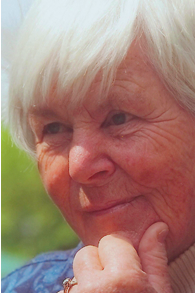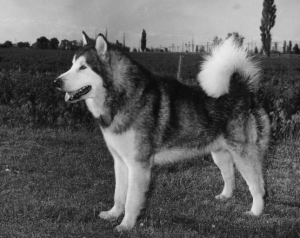547 – Canine Herpes Virus: Early Detection Saves Puppies
Canine Herpes Virus: Early Detection Saves Puppies
Alaskan Malamute breeder Wendy Corr joins host Laura Reeves to share her story of early detection of Canine Herpes Virus in her pregnant bitch and how she managed the situation to produce healthy puppies. This is the first of a two-part series which also includes an interview with Corr’s lead veterinarian.

November 2021 4-6 Beginner Puppy. Later, breeder, owner, handler Wendy Corr related his story, told here.
Corr said she had never really thought about CHV much, as a long-time breeder, but had recently heard a presentation on the dangers of the disease to pregnant females. On a whim, she asked her veterinarian, Dr. Bruce Christensen, to pull blood a CHV titer test on her confirmed pregnant 3-year-old Malamute.
She was shocked to hear back a couple weeks later that the bitch had titer levels off the charts.
At the direction of Dr. Christensen and his team at Kokopelli Assisted Reproductive Canine Services in Sacramento, CA, Corr started her bitch on a course of acyclovir, a human anti-viral.
Corr, who is a clinical nurse in human medicine, said she was concerned about potential side effects from the drug, which could include cleft palate, but committed to the treatment with that understanding. She also opted for a C-section, rather than a vaginal whelp, in order to limit the puppies’ exposure to the virus in the dam’s body.
Primary among the handling of the four healthy puppies at birth (none with clefts) was incorporating an incubator to keep their body temperature above 99 degrees, the point at which the virus cannot replicate, for the first 2 ½ weeks. Putting the puppies on to nurse every two hours, monitoring temps and keeping mom and puppies content during that time was a daunting challenge, Corr said.
“We had friends who brought us dinner,” Corr said. “We had people who offered to come in and just sit with the dog so I could sleep or take a shower or we could go grocery shopping.”
The entire process took place during the height of COVID lockdowns, enhancing Corr’s challenges.
Stay tuned next week for insight from Dr. Christensen directly on his experience and recommendations on the topic.
230 – Storm Kloud Alaskan Malamutes: Continuation of a Dream
Storm Kloud team of Alaskan Malamutes proved their heritage in 1994
After two years and 3,000 hours of training, Nancy Russell’s Storm Kloud Alaskan Malamutes were ready to compete in the iconic Iditarod Race in 1994.
Russell shares her stories of this epic journey, noting that she was proud to show that “Our dogs can still go on and do what they were bred to do.”
Twenty below for eight days
Russell and her crew drove with the five females and 10 males, all but one bitch intact, that made the final team. “It was 20 below zero when we left Minnesota. And it never got above that for eight days, all the way to Alaska,” Russell said.
“There was no snow in Anchorage,” Russell said “so they hauled in snow and put enough on the street to run the teams 15 blocks. Because a driver would not be able to set a snow hook if they had trouble with a team, an extra person had to ride with them. Therefore I got to ride in the sled for the ceremonial start of 15 blocks that year. Jamie chose 5 Champions and Josh to run as only 6 dogs were allowed in the team.”
Dog aggression was a major concern for the race organizers, Russell noted. The Alaskan Malamutes of the day were considered very “tough.” Part of the hours of training was that “we had to be sure the dogs could pass (another team of dogs) without causing problem before would be *allowed* to run this team,” Russell said.
Show dogs to team
Another obstacle, Russell said, is that the “show dogs” had to learn to be part of a team. Of the 15 dogs on the team, 11 were or became show champions.
“Show dog is not a team event,” Russell said. “Going from ‘I am the coolest’ to teamwork was a huge issue for Jamie (Nelson, the professional musher who trained and ran the team) to overcome. She had a hard time getting the dogs past people with cameras… the dogs were so convinced they were cool…”
Russell was amazed that the dogs actually gained weight along the route of the race. She noted that the dogs would push away the straw put down for bedding and held up well in the arctic environment of their heritage.
Danger on the trail
“When Jamie arrived at Finger Lake she went into a Dodge Lodge (tent furnished for the mushers) to sleep,” Russell said. “Later she woke as she was cold and went to get her sleeping bag. She was unable to stand and crawled out and then realized they were being asphyxiated from the stove. She crawled back in and turned it off and tried to wake the other mushers but could not wake them. She called for help and Beth Baker MD who was in the checkpoint heard her and they got them out. Jamie and Beth received the Sportsmanship award for saving the lives of the other four mushers.”
Eskimo welcome
The native people were thrilled when the team arrived near their communities.
“When they got to the Eskimo villages, the school teachers let kids come out of school to see the Malamutes,” Russell said. “One elderly gentleman came and brought his grandkids. He said ‘you have to see these dogs. This is what we used to have.’”
The struggle, Russell said, was the dogs’ feet. The weather was unusual that year, she noted, with rising temperatures causing rivers to melt.
“The dogs went through the river,” Russell said, “but the conditions caused a number of dogs to have feet susceptible to injury.”
Feet are the foundation
Despite special boots designed for the dogs, the team was struggling with ice balls in their pads and swollen feet in the boots.
“I do feel people are breeding smaller, tighter feet because they are pretty, not because they are functional,” Russell said. “The snowshoe foot, as described in the standard, doesn’t look as nice in the show ring.”
The dogs’ feet were what caused them to end their run after 640 miles of the 1,500 mile race, Russell said.
“Here I was in Ruby, more than halfway through the race, trying to make the decision. The dogs’ feet had gotten progressively worse in the last 300 miles. When I bootied them they swelled up. When I ran without, they snowballed within a few miles. The vets and I had tried everything we knew. I was running out of options. It seemed such a shame. For the most part, their bodies were like fine-honed machines. They could easily have completed the course. Only their foot problems were to let them down. Yet they were the feet that had carried me close to 600 miles in less than seven days through some of most rugged country Alaska had to offer. To take advantage of their willingness to please and push them on in their condition wouldn’t give us any more answers, only serve to inflict unnecessary pain. I thought back now to the time we had spent training together. I had worked with some these guys for four years and trained intensely for the better part of the last two years. They had taxed every bit of my knowledge on training. They had tried me every step of the way and through this I had grown to love these guys. But, it wasn’t just love I was feeling now, it was something else. They had developed a trust in me, a trust that I would always do what ‘s right for them. A bond of trust that is stronger than love or even life itself, a trust that once broken can never be regained. I went back and took another look at their feet, then I looked into their eyes, and the decision was made.” — Musher Jamie Nelson
By any calculation, 15 show dogs running in harness for 640 miles in the brutal arctic conditions is a tremendous accomplishment. Russell remains proud of her dogs’ ability to prove the breed can still do its job in the most extreme conditions. Listen to part one of this story here.
228 – Alaskan Malamute Breeder Pursued a Dream to Run the Iditarod
Legendary Storm Kloud Alaskan Malamute Breeder Nancy Russell Shares Her Story
In 1994 Nancy Russell bred and fielded the only AKC registered Alaskan Malamute team to ever enter and compete in the Iditarod. In part one, today’s talk, she shares the foundation of that journey, her breeding program and some of the incredible stories along the way. In part two next week Russell takes us through the arduous process of actually competing in the greatest endurance race on Earth.
Russell acquired her first Alaskan Malamute in 1964. She became involved in showing dogs, like so many of us, by going to her first dog show at the suggestion of her mentor.
“I got a blue ribbon and a trophy,” Russell said. “(My dog) beat two other dogs. I was hooked.”
At that show Russell saw what “I still believe is the best Malamute I’ve ever seen.” His name was Bear, Multiple Best In Show, Best In Specialty Show, American/Canadian/Mexican/International Champion Glacier’s Storm Kloud CD ROM ROM-OB ROM-WD CAM.
Bear was bred to Russell’s foundation bitch and she also eventually purchased him from his breeder. Inbreeding on Bear laid the foundation that produced the entire 15-dog Iditarod team, 11 of which were show champions.
Russell said she was always fascinated by Alaska, mushing and, the ultimate, the Iditarod. She dreamed of competing with a team of Malamutes in the 1,150-mile race from Anchorage to Nome, Alaska.
“To me this would be a real test of the Alaskan Malamute’s ability to go back and do what it was bred to do,” Russell said.
Professional musher Jamie Nelson, from Minnesota, trained, conditioned and developed the team.
“I could never have gotten the team to the Iditarod without the help of Jan Richards,” Russell said, “who took a 6 months leave of absence from her teaching job to move to Jamie’s and help with the organizing of the supplies, correspondence and help with training with an extra team. Mark Scepanski spent a year helping Jamie train both the Malamute and her Alaskan team.”
Enjoy today’s journey through time as Russell shares more than 50 years of insight on breeding, training, socializing and judging the Alaskan Malamute.
For more information, visit:






